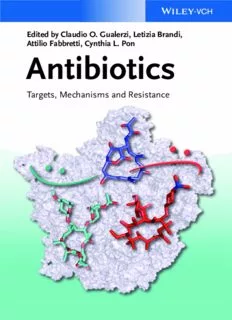
Antibiotics: Targets, Mechanisms and Resistance PDF
Preview Antibiotics: Targets, Mechanisms and Resistance
Edited by Claudio O. Gualerzi, Letizia Brandi, Attilio Fabbretti, Cynthia L. Pon Antibiotics Targets, Mechanisms and Resistance Editedby ClaudioO.Gualerzi,LetiziaBrandi, AttilioFabbretti,andCynthiaL.Pon Antibiotics RelatedTitles Phoenix,D.A.,Dennison,S.,andHarris,F. Arya,D.P.(ed.) AntimicrobialPeptides Aminoglycoside Antibiotics FromChemicalBiologytoDrugDiscovery 2013 PrintISBN:978-3-527-33263-2,alsoavailablein 2007 electronicformats PrintISBN:978-0-471-74302-6,alsoavailablein electronicformats Sko¨ld,O. Tolmasky,M.andBonomo,R.(eds.) Antibiotics andAntibiotic Resistance Enzyme-MediatedResistanceto Antibiotics 2011 PrintISBN:978-0-470-43850-3,alsoavailablein 2007 electronicformats PrintISBN:978-1-555-81303-1 Selzer,P.M.(ed.) AntiparasiticandAntibacterial DrugDiscovery FromMolecularTargetstoDrug Candidates 2009 PrintISBN:978-3-527-32327-2,alsoavailablein electronicformats Edited by Claudio O. Gualerzi, Letizia Brandi, Attilio Fabbretti, and Cynthia L. Pon Antibiotics Targets, Mechanisms and Resistance TheEditors AllbookspublishedbyWiley-VCHare carefullyproduced.Nevertheless,authors, editors,andpublisherdonotwarrantthe ClaudioO.Gualerzi informationcontainedinthesebooks, LaboratoryofGenetics includingthisbook,tobefreeoferrors. DepartmentofBiosciencesand Readersareadvisedtokeepinmindthat Biotechnology statements,data,illustrations,procedural UniversityofCamerino detailsorotheritemsmayinadvertentlybe 62032Camerino inaccurate. Italy LetiziaBrandi LibraryofCongressCardNo.:appliedfor LaboratoryofGenetics DepartmentofBiosciencesand BritishLibraryCataloguing-in-Publication Biotechnology Data UniversityofCamerino Acataloguerecordforthisbookisavailable 62032Camerino fromtheBritishLibrary. Italy Bibliographicinformationpublishedbythe AttilioFabbretti DeutscheNationalbibliothek LaboratoryofGenetics TheDeutscheNationalbibliothek DepartmentofBiosciencesand liststhispublicationintheDeutsche Biotechnology Nationalbibliografie;detailedbibliographic UniversityofCamerino dataareavailableontheInternetat 62032Camerino <http://dnb.d-nb.de>. Italy CynthiaL.Pon ©2014Wiley-VCHVerlagGmbH&Co. LaboratoryofGenetics KGaA,Boschstr.12,69469Weinheim, DepartmentofBiosciencesand Germany Biotechnology UniversityofCamerino Allrightsreserved(includingthoseof 62032Camerino translationintootherlanguages).Nopart Italy ofthisbookmaybereproducedinany form–byphotoprinting,microfilm,orany othermeans–nortransmittedortranslated intoamachinelanguagewithoutwritten permissionfromthepublishers.Registered names,trademarks,etc.usedinthisbook, evenwhennotspecificallymarkedassuch, arenottobeconsideredunprotectedbylaw. PrintISBN:978-3-527-33305-9 ePDFISBN:978-3-527-65971-5 ePubISBN:978-3-527-65970-8 MobiISBN:978-3-527-65969-2 oBookISBN:978-3-527-65968-5 CoverDesign Grafik-DesignSchulz, Fußgo¨nheim Typesetting LaserwordsPrivateLtd., Chennai,India PrintingandBinding MarkonoPrintMedia PteLtd.,Singapore Printedonacid-freepaper V Contents Preface XVII ListofContributors XIX 1 AChemist’sSurveyofDifferentAntibioticClasses 1 SoniaIlariaMaffioli 1.1 Introduction 1 1.2 Aminoglycosides 1 1.3 β-Lactams 3 1.4 LinearPeptides 4 1.4.1 Glycopeptides-Dalbaheptides 4 1.4.2 Lantibiotics 6 1.5 CyclicPeptides 8 1.6 Thiazolylpeptides 11 1.7 Macrolactones 13 1.7.1 Macrolides 13 1.7.2 Difimicin 15 1.8 Ansamycins–Rifamycins 15 1.9 Tetracyclines 16 1.10 Oxazolidinones 16 1.11 Lincosamides 18 1.12 Pleuromutilins 18 1.13 Quinolones 19 1.14 Aminocoumarins 19 References 20 2 AntibacterialDiscovery:ProblemsandPossibilities 23 LynnL.Silver 2.1 Introduction 23 2.2 WhyIsAntibacterialDiscoveryDifficult?TheProblems 24 2.3 TargetChoice:Essentiality 24 2.4 TargetChoice:Resistance 26 2.5 CellEntry 31 VI Contents 2.6 ScreeningStrategies 32 2.6.1 EmpiricalScreens 32 2.6.2 PhenotypicWhole-CellScreens 34 2.6.3 InVitroScreensforSingle-TargetInhibitors 37 2.6.4 ChemicalstoScreen 38 2.6.4.1 ChemicalCollections 38 2.7 NaturalProducts 40 2.8 ComputationalChemistry,VirtualScreening,Structure-and Fragment-BasedDrugDesign(SBDDandFBDD) 42 2.9 Conclusions 45 References 46 3 ImpactofMicrobialNaturalProductsonAntibacterialDrug Discovery 53 GabriellaMolinari 3.1 Introduction 53 3.2 NaturalProductsforDrugDiscovery 54 3.3 MicrobialNaturalProducts 56 3.4 TheChallengeofFindingNovelAntibioticsfromNewNatural Sources 59 3.5 WorkflowforDrugDiscoveryfromMicrobialNaturalProducts 60 3.6 AntimicrobialActivities:TargetsforScreens 63 3.7 NaturalProducts:AContinuingSourceforInspiration 65 3.8 GenomeMininginNaturalProductDiscovery 66 3.9 Conclusions 67 References 68 4 AntibioticsandResistance:AFatalAttraction 73 GiuseppeGalloandAnnaMariaPuglia 4.1 ToBeorNottoBeResistant:WhyandHowAntibioticResistance MechanismsDevelopandSpreadamongBacteria 73 4.1.1 HorizontalandVerticalTransmissionofResistanceGenes 74 4.2 BacterialResistancetoAntibioticsbyEnzymaticDegradationor Modification 79 4.2.1 AntibioticResistancebyHydrolyticEnzymes 80 4.2.1.1 β-Lactamases 81 4.2.1.2 MacrolideEsterases 81 4.2.1.3 Epoxidases 81 4.2.1.4 Proteases 83 4.2.2 AntibioticTransferasesPreventTargetRecognition 83 4.2.2.1 Acyltransfer 83 4.2.2.2 Phosphotransferases 84 4.2.2.3 Nucleotidyltransferases 85 4.2.2.4 ADP-Ribosyltransferases 85 4.2.2.5 Glycosyltransferases 85 Contents VII 4.2.3 RedoxEnzymes 86 4.3 AntibioticTargetAlteration:TheTrickExistsandItIsinthe Genetics 86 4.3.1 Low-AffinityHomologousGenes 86 4.3.1.1 RifamycinLow-AffinityRpoB 87 4.3.1.2 MutatedGenesConferringResistancetoQuinolone,Fluoroquinolone andAminocoumarins 87 4.3.1.3 PBP2a:ALow-AffinityPenicillin-BindingProtein 87 4.3.1.4 DihydropteroateSynthasesNotInhibitedbySulfonamide 88 4.3.2 ChemicalModificationofAntibioticTarget 88 4.3.2.1 23SrRNAModification 88 4.3.2.2 16SrRNAModification 88 4.3.2.3 ReprogrammingChemicalCompositionofaBacterialCell-Wall Precursor 89 4.3.3 RibosomalProtectionandTetracyclineResistance 89 4.3.4 ChromosomalMutationsinGenesRequiredforMembrane PhospholipidMetabolism:LipopeptideResistance 91 4.3.5 CovalentModificationsonLipopolysaccharideCoreConferring PolymixineResistance 92 4.4 EffluxSystems 92 4.4.1 TheATP-BindingCassette(ABC)Superfamily 94 4.4.2 TheMajorFacilitatorSuperfamily(MSF) 94 4.4.3 TheSmallMultidrug-ResistanceFamily(SMR) 96 4.4.4 TheResistance-Nodulation-Division(RND)Superfamily 96 4.4.5 TheMultidrugandToxicCompoundExtrusion(MATE)Family 97 4.5 TheCaseStoriesofIntrinsicandAcquiredResistances 98 4.5.1 β-LactamResistomeof P.aeruginosa:IntrinsicResistanceIsGenetically Determined 98 4.5.2 AcquiredAntibioticResistanceinS.aureus 98 4.5.2.1 AcquiredResistancetoβ-LactamsandGlycopeptides 99 4.5.2.2 AcquiredResistancetoFluoroquinolones 100 4.6 StrategiestoOvercomeResistance 100 References 101 5 FitnessCostsofAntibioticResistance 109 PietroAlifano 5.1 Introduction 109 5.2 MethodstoEstimateFitness 110 5.2.1 ExperimentalMethods 110 5.2.2 EpidemiologicalMethods 111 5.3 FactorsAffectingFitness 112 5.3.1 GeneticNatureoftheResistantDeterminant 112 5.3.2 ExpressionoftheAntibiotic-ResistanceDeterminant 118 5.3.3 MicrobialCellPhysiology,Metabolism,andLifestyle 119 5.3.4 GeneticBackgroundoftheAntibiotic-ResistantMutant 120 VIII Contents 5.4 MechanismsandDynamicsCausingPersistenceofChromosomaland Plasmid-BorneResistanceDeterminants 121 5.4.1 CompensatoryGeneticMechanismsThatRestoreorImproveFitness withoutLossofResistance 121 5.4.2 LinkedSelectionandSegregationStabilityofResistance Determinants 126 5.4.3 ReacquisitionofAntimicrobialResistance 127 References 128 6 InhibitorsofCell-WallSynthesis 133 StefanoDonadioandMargheritaSosio 6.1 Introduction 133 6.2 MraYInhibitors 134 6.3 LipidIITargetingCompounds 137 6.3.1 Glycopeptides 137 6.3.2 Lantibiotics 139 6.3.3 RamoplaninandEnduracidin 143 6.3.4 OtherCompounds 143 6.4 BactoprenolPhosphate 145 6.5 Conclusions 146 Acknowledgments 146 References 147 7 InhibitorsofBacterialCellPartitioning 151 BhavyaJindal,AnusriBhattacharya,andDulalPanda 7.1 Introduction 151 7.2 BacterialCellDivision 152 7.2.1 FilamentousTemperature-SensitiveZ(FtsZ) 152 7.2.2 StructureandAssemblyPropertiesofFtsZ 152 7.2.3 Z-Ring:ADynamicStructureThatDrivesBacterialCellDivision 153 7.2.4 ProteinsRegulatingFtsZAssembly 155 7.2.5 ProteinsInvolvedinSeptumFormation 156 7.2.6 RoleofOtherCytoskeletonProteinsinBacterialCellDivision 157 7.3 CellDivisionProteinsasTherapeuticTargets 158 7.3.1 FtsZasaTherapeuticTarget 158 7.3.1.1 IdentificationofFtsZ-TargetingAntibacterialAgents 158 7.3.1.2 FtsZInhibitors 161 7.3.2 OtherCellDivisionProteinsasTherapeuticTargets 170 7.4 StatusofFtsZ-TargetingCompounds:FromLaboratorytoClinic 172 7.5 Conclusion 173 Acknowledgment 173 Abbreviations 173 References 174
Description: